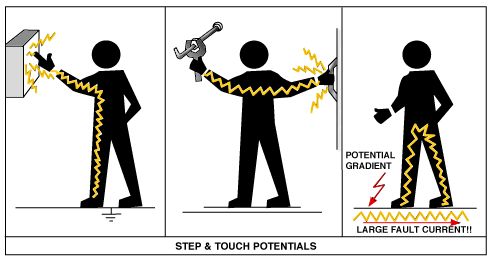Identifying electrical safety hazards.
When electrical systems break down what are the primary hazards and what are the consequences to personnel? Electric shock Exposure to Arc-Flash Exposure to Arc-Blast Exposure to excessive light and sound energies
Secondary hazards may include burns, the release of toxic gases, molten metal, airborne debris and shrapnel. Unexpected events can cause startled workers to lose their balance and fall from ladders or jerk their muscles possibly causing whiplash or other injuries.
Electric Shock
When personnel come in contact with energized conductors they receive a shock with current flowing through their skin, muscles and vital organs. The severity of the shock depends on the current’s path through the body, the current intensity, and the duration of the contact.
They may only experience a mild tingling sensation or it could result in serious injury or death. As voltage levels increase, the effects of electric shock escalate. Current may also cause an erratic heartbeat known as ventricular fibrillation.
If fibrillation occurs even briefly and goes untreated, the effects are usually fatal. A clear understanding of how electric current travels through the body can help minimize injury if such contact occurs. The table below outlines the effects that various values of electrical current have on the human body.
There are three basic pathways electric current travels through the body;
1) Touch Potential (hand/hand path)
2) Step Potential (foot/foot path)
3) Touch/Step Potential (hand/foot path)

1) In a touch potential contact, current travels from one hand through the heart and out through the other hand. Because the heart and lungs are in the path of current, ventricular fibrillation, difficulty in breathing, unconsciousness, or death may occur.
2) In a step potential contact, current travels from one foot through the legs, and out of the other foot. The heart is not in the direct path of current but the leg muscles may contract, causing the victim to collapse or be momentarily paralyzed.
3) In a touch/step potential contact, current travels from one hand, through the heart, down the leg, and out of the foot. The heart and lungs are in the direct path of current so ventricular fibrillation, difficulty in breathing, collapse, unconsciousness, or death may occur.
Even though there may be no external signs from the electrical shock, internal tissue or organ damage may have occurred. Signs of internal damage may not surface immediately; and when it does, it may be too late.
Any person experiencing any kind of electrical shock should seek immediate medical attention. Using the correct personal protective equipment (PPE) and following safe work practices will minimize risk of electrical shock hazards.
Arc-Flash and Arc Blasts
An Arc-Flash is an unexpected sudden release of heat and light energy produced by electricity traveling through air, usually caused by accidental contact between live conductors. Temperatures at the arc terminals can reach or exceed 35,000 degrees Fahrenheit (F), or four times the temperature of the sun’s surface.
The air and gases surrounding the arc are instantly heated and the conductors are vaporized causing a pressure wave called an Arc Blast. Personnel directly exposed to an Arc-Flash and Arc-Blast events are subject to third degree burns, possible blindness, shock, blast effects and hearing loss. Even relatively small arcs can cause severe injury.
The secondary effect of arcs includes toxic gases, airborne debris, and potential damage to electrical equipment, enclosures and raceways. The high temperatures of the arc and the molten and vaporized metals quickly ignite any flammable materials.
While these fires may cause extensive property damage and loss of production, the hazards to personnel are even greater. Any energized electrical conductor that makes accidental contact with another conductor or with ground will produce an Arc-Flash.
The arcing current will continue to flow until the overcurrent protective device used upstream opens the circuit or until something else causes the current to stop flowing. The arc current can vary up to the maximum available bolted fault current